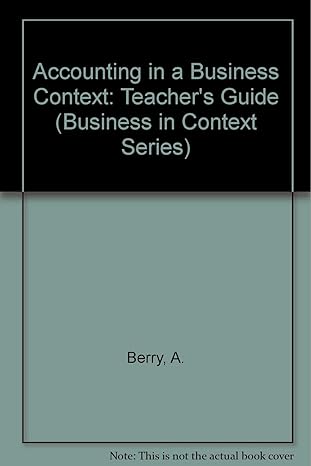Answered step by step
Verified Expert Solution
Question
1 Approved Answer
Lou Lewis, the president of Lewisville Company, has asked you to give him an analysis of the best use of a warehouse the company owns.
Lou Lewis, the president of Lewisville Company, has asked you to give him an analysis of the best use of a warehouse the company owns. Note. The company has a 38% effective tax rate. a. Lewisville Company is currently leasing the warehouse to another company for $5,400 per month on a year-to-year basis. (Hint Use the PV function in Excel to calculate, on an after-tax basis, the PV of this stream of monthly rental receipts.) b. The warehouse's estimated sales value is $210,000. A commercial realtor believes that the price is likely to remain unchanged in the near future. The building originally cost $62,000 and is being depreciated at $1,700 annually. Its current net book value (NBV) is $7,700. c. Lewisville Company is seriously considering converting the warehouse into a factory outlet for furniture. The remodeling will cost $120,000 and will be modest because the major attraction will be rock-bottom prices. The remodeling cost will be depreciated over the next 5 years using the double-declining-balance method. (Note: Use the VDB function in Excel to calculate depreciation charges. The advantage of using the VDB, rather than the DDB, function is that there is a (default) option in the former that provides an automatic switch to the straight-line method when it is advantageous to do so.) d. The inventory and receivables (net of current liabilities) needed to open and sustain the factory outlet would be $630,000. This total is fully recoverable whenever operations terminate. e. Lou is fairly certain that the warehouse will be condemned in 10 years to make room for a new highway. The firm most likely would receive $220,000 from the condemnation. f. Estimated annual operating data, exclusive of depreciation, are as follows: Sales (cash) Operating expenses $920,000 $520,000 g Nonrecurring sales promotion costs at the beginning of year 1 (.e., at time 0) are expected to be $106,000. (These costs are fully deductible for tax purposes.) h. Nonrecurring termination costs at the end of year 5 are $54,000. (These costs are fully deductible for tax purposes.) 1. The after-tax discount rate for capital budgeting purposes is 11%. (To calculate the present value factor for each year, /, /= 1,5, use the following formula: PV factor, = (1+111). The company is in the 38% tax bracket (federal and state combined). Required: 1. Show how you would handle the individual items in determining whether the company should continue to lease the space or convert it to a factory outlet. Use PV function in Excel, VDB function in Excel to calculate annual depreciation charges. Use NPV function to calculate depreciation tax savings. 2. Indicate which course of action, based only on these data, should be taken. Required. 1. Show how you would handle the individual items in determining whether the company should continue to lease the space or convert it to a factory outlet. Use PV function in Excel, VDB function in Excel to calculate annual depreciation charges. Use NPV function to calculate depreciation tax savings. 2. Indicate which course of action, based only on these data, should be taken. Complete this question by entering your answers in the tabs below. Req 1 Req 2 Show how you would handle the individual items in determining whether the company should continue to lease the space or convert it to a factory outlet. Use PV functions function in Excel to calculate annual depreciation charges. Use NPV function to calculate depreciation tax savings. (Negative amounts should be indicated by a minus sign. answers to the nearest whole dollar.) Rem Description a. After-lax monthly rent foregone Current warehouse C Remodeling cost (capitalized) Depreciation tax savings (DDB method, @38%) d Investment in net working capital Recovery of net working capital 10 After-tax cash sales After-tax cash operating expenses a After-tax sales promotion cost, year 0 Aher-tax termination cost, year 5 NPV PV Cash Flows in Year 3
Step by Step Solution
There are 3 Steps involved in it
Step: 1

Get Instant Access to Expert-Tailored Solutions
See step-by-step solutions with expert insights and AI powered tools for academic success
Step: 2

Step: 3

Ace Your Homework with AI
Get the answers you need in no time with our AI-driven, step-by-step assistance
Get Started


